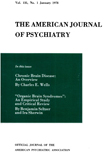FOLLOW-UP STUDY OF PSYCHONEUROSES
Abstract
1. Although approximately 50% of a representative sample of enlisted men with psychoneurotic disorders during World War II had significant and clinically recognizable psychiatric difficulty prior to entering the service, the remainder were sufficiently well adjusted that they could not have been rejected for induction under any conceivable screening examination. Even the group with overt neuroses prior to entering the service was by no means a total loss; in 18% breakdown did not occur except under the stress of combat; 32% served overseas; 30% were demobilized without requiring a medical discharge.
2. Combat was by far the most frequent stress that resulted in breakdown.
3. At the time of separation from service 70% either were not ill or had neuroses that were not severe. Disability discharge was not necessarily associated with marked disability at follow-up. On the basis of the degree of disability in civilian life associated with varying degrees of severity of psychoneurotic disorders it is estimated that about 6o% of those who received disability discharges were capable of working full-time in some capacity at the time of separation.
4. At follow-up 45% had essentially no disability and an additional 27% had symptoms that were not more than slightly disabling. Only 8% were severely or totally disabled.
5. Sixty-five percent have had no treatment since separation and an additional 21% have received only symptomatic treatment by nonpsychiatrists. There remains a considerable need for psychiatric treatment.
6. Forty-seven percent were receiving disability compensation, half of them less than $20 per month. In only 19% of the cases receiving compensation did the examiner feel that compensation had an ill effect. It was found that 37% of those who seemed to have no disability were receiving compensation.
7. The psychoneurotic disorder is not static. The condition of more than half of the men has improved since separation. Most of those who were not disabled at follow-up had improved since separation from the service, but most of those who were severely disabled at follow-up had become worse since separation. (This seems to bear no strong relationship to preservice personality.)
8. The majority of those who were severely or totally disabled at follow-up had had some psychiatric difficulty prior to service. Also, 70% of the men reported their health at follow-up as worse than on entry into the service, and 30% reported it as unchanged or better.
9. Severity and duration of combat are not related to degree of disability at follow-up.
10. There is a suggestion that discharge for disability in itself may contribute to the perpetuation or aggravation of a psychoneurotic disorder.
11. Symptoms that were no more than slightly disabling were observed at follow-up in 92% of those who had been well integrated prior to service, in 61% of those who had overt neuroses, and in 49% of those with pathological personalities prior to service. Conversely, 8% of the normal group, 39% of the overtly neurotic group, and 51% of the pathological personality group were classified as moderately to totally disabled.
12. The degree of disability on follow-up is related to the extent of psychopathology in the parents.
Access content
To read the fulltext, please use one of the options below to sign in or purchase access.- Personal login
- Institutional Login
- Sign in via OpenAthens
- Register for access
-
Please login/register if you wish to pair your device and check access availability.
Not a subscriber?
PsychiatryOnline subscription options offer access to the DSM-5 library, books, journals, CME, and patient resources. This all-in-one virtual library provides psychiatrists and mental health professionals with key resources for diagnosis, treatment, research, and professional development.
Need more help? PsychiatryOnline Customer Service may be reached by emailing [email protected] or by calling 800-368-5777 (in the U.S.) or 703-907-7322 (outside the U.S.).



